Occurrences and Perspectives of Natural Hydrogen Extraction: The Brazilian Context
Abstract
1. Introduction
2. Contextualization
3. Natural Hydrogen
3.1. Serpentinization
3.2. Radiolysis
3.3. Rock Fracturing
3.4. Magma Degassing
3.5. Extraction
- Drilling a single wellbore can extract natural hydrogen that has become trapped in a subterranean space. Salt rocks and other impermeable formations can serve as cap rocks to confine natural hydrogen underneath.
- By drilling a single wellbore from the ground surface to the level of the iron-rich formation, the produced natural hydrogen can be collected from shallow iron-rich formations that are continuously exposed to hot groundwater.
- An increased hydrogen recovery method can be used in situations when there is insufficient groundwater to serpentinize the shallow iron-rich deposits. In order to create economically viable concentrations of natural hydrogen, water is pumped into the iron-rich formation from the injection well. The produced hydrogen is then drawn out of the well. For sequestration purposes, carbon dioxide can also be poured into the earth using this method.
4. Materials and Methods
5. Results and Discussion
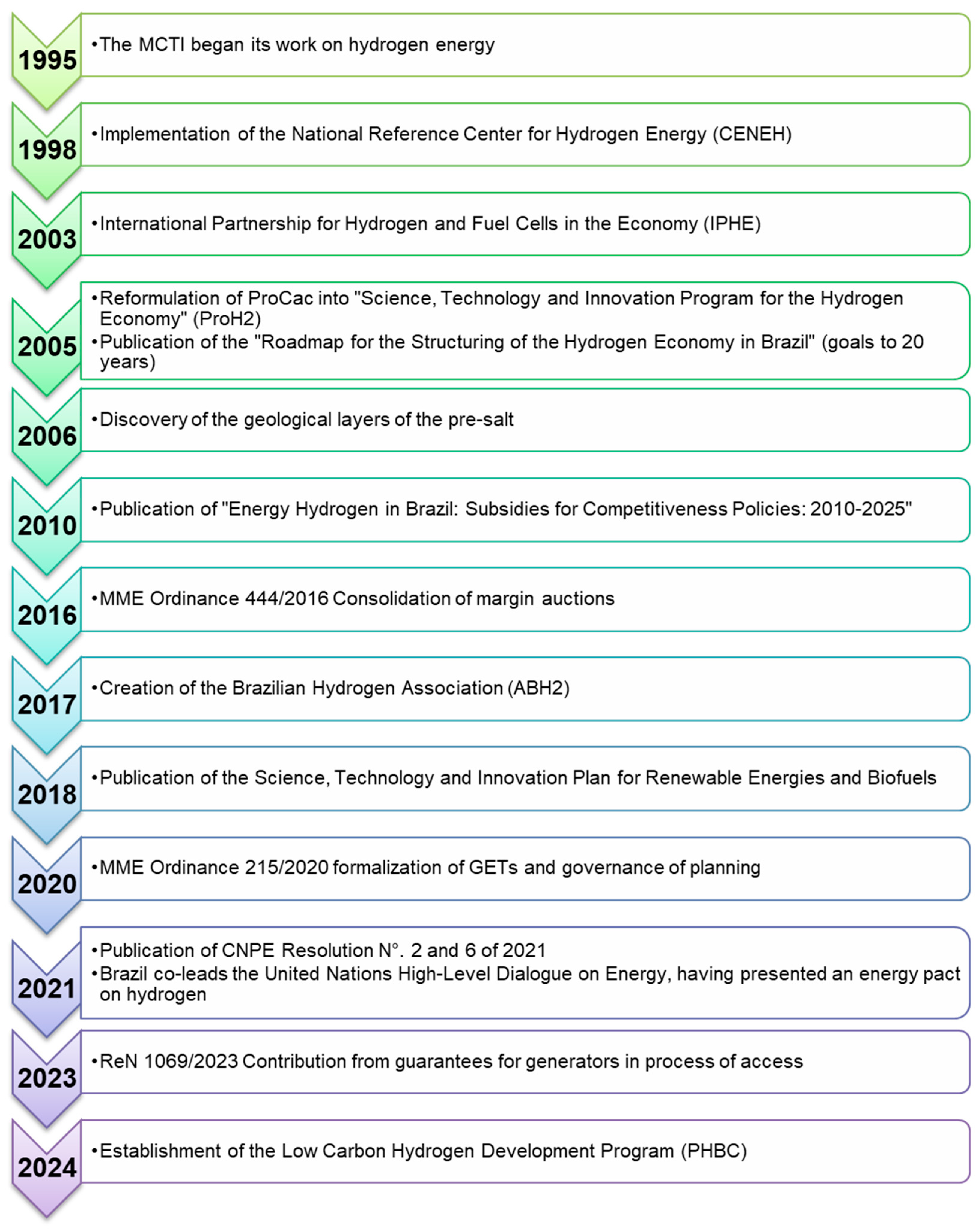
6. Conclusions
- -
- In 2022, the global use of hydrogen was 95 Mt and is expected to reach, by 2030, more than 150 Mt.
- -
- Projections show that in 2030, hydrogen will be intensively used in different processes and activities: processes of refining (37.0 Mt), ammonia (34.5 Mt), methanol (17.1 Mt), steel (12.7 Mt), and others (51.0 Mt). Additional uses include power generation, transportation, buildings, and high-temperature industrial heat.
- -
- Over USD 25 billion has already been announced for investments in green hydrogen generation plants in Brazil. The Port of Pecém (Ceará), Port of Suape (Pernambuco), and Port of Açu (Rio de Janeiro) are the main locations for investments.
- -
- The projects in Brazil will produce a total of 12,921 MW and 2237 Kt/year of green hydrogen by 2030.
- -
- The growing research in Brazil is explained mainly due to the potential of natural hydrogen sources being studied in the São Francisco Basin and states such as Goias, Tocantins, Minas Gerais, Roraima, Bahia, and Ceará, as well as due to the successful exploration of Bourakebougou (Mali) and more recently to the Albanian discovery.
- -
- The main origins proposed for natural hydrogen are serpentinization, magma degassing, radiolysis, and rock fracturing.
- -
- Direct drilling of iron-rich rocks or deposits trapped by salt layers can be utilized to recover natural hydrogen, which is a technique similar to that already employed in the oil and gas sector.
- -
- The number of hydrogen research studies presented an exponential growth curve in recent years, also due to the search for energy security and diversification global energy matrix.
- -
- The countries in which researchers published on the topic were France, China, the United States, Australia, Brazil, Scotland, Russia, and Germany, respectively.
- -
- Because there are so few examples of natural hydrogen being produced, it is difficult to assess its potential cost, but it is expected to have a lower cost when compared to green hydrogen.
- -
- The Hydroma industry estimates natural hydrogen costs at 0.5 USD/kg, while projects in Australia and Spain have approximately 1 USD/kg as a target price. Since drilling is the most prevalent method of securing access to these energy-related natural resources, it is essential to maintain a transfer of knowledge and technology from the oil and gas business to the hydrogen industry in order to access natural hydrogen accumulations.
- -
- Estimates indicate that natural hydrogen can supply global energy demand for centuries, facilitating the decarbonization of the energy sector. However, there are uncertainties, such as the need to better understand the geological processes that govern the generation of natural hydrogen, the behavior of reservoirs over time, and the effectiveness of extraction technologies.
- -
- In Brazil, more geophysical and geochemical studies are needed to confirm the viability of these reserves.
- -
- The discovery of natural hydrogen will also require a solid regulatory framework and a dialogue between government, companies, and society to make its exploitation viable. The potential is great, but the technical and regulatory challenges require collaboration for sustainable exploration.
Author Contributions
Funding
Acknowledgments
Conflicts of Interest
References
- Tian, X.; Pei, J. Study Progress on the Pipeline Transportation Safety of Hydrogen-Blended Natural Gas. Heliyon 2023, 9, e21454. [Google Scholar] [CrossRef] [PubMed]
- Agência Nacional do Petróleo. Boletim Mensal da Produção de Petróleo e Gás Natural—Agência Nacional do Petróleo, Gás Natural e Biocombustíveis. Available online: https://www.gov.br/anp/pt-br/centrais-de-conteudo/publicacoes/boletins-anp/boletins/boletim-mensal-da-producao-de-petroleo-e-gas-natural (accessed on 26 January 2025).
- Ministério de Minas e Energia. Plano Decenal de Expansão de Energia 2034; Ministério de Minas e Energia: Brasília, Brazil, 2024.
- Klatzer, T.; Bachhiesl, U.; Wogrin, S. State-of-the-Art Expansion Planning of Integrated Power, Natural Gas, and Hydrogen Systems. Int. J. Hydrogen Energy 2022, 47, 20585–20603. [Google Scholar] [CrossRef]
- Achomo, M.A.; Kumar, A.; Peela, N.R.; Muthukumar, P. Hydrogen Production from Steam Reforming of Methanol: A Comprehensive Review on Thermodynamics, Catalysts, Reactors, and Kinetic Studies. Int. J. Hydrogen Energy 2024, 58, 1640–1672. [Google Scholar] [CrossRef]
- Ministério de Minas e Energia. Plano Nacional de Energia 2050; Ministério de Minas e Energia: Brasília, Brazil, 2020.
- International Energy Agency. Electrification—Energy System. Available online: https://www.iea.org/energy-system/electricity/electrification (accessed on 15 January 2025).
- Blay-Roger, R.; Bach, W.; Bobadilla, L.F.; Reina, T.R.; Odriozola, J.A.; Amils, R.; Blay, V. Natural Hydrogen in the Energy Transition: Fundamentals, Promise, and Enigmas. Renew. Sustain. Energy Rev. 2024, 189, 113888. [Google Scholar] [CrossRef]
- Maiga, O.; Deville, E.; Laval, J.; Prinzhofer, A.; Diallo, A.B. Trapping Processes of Large Volumes of Natural Hydrogen in the Subsurface: The Emblematic Case of the Bourakebougou H2 Field in Mali. Int. J. Hydrogen Energy 2024, 50, 640–647. [Google Scholar] [CrossRef]
- Wang, L.; Cheng, J.; Jin, Z.; Sun, Q.; Zou, R.; Meng, Q.; Liu, K.; Su, Y.; Zhang, Q. High-Pressure Hydrogen Adsorption in Clay Minerals: Insights on Natural Hydrogen Exploration. Fuel 2023, 344, 127919. [Google Scholar] [CrossRef]
- Zhang, X.; Fan, X.Y.; Wang, K. Exploration on Whole Industrial Chain for Traditional Petrochemical Enterprises to Develop Hydrogen Energy Business. Mod. Chem. Ind. 2021, 41, 9–13. [Google Scholar] [CrossRef]
- Wang, L.; Jin, Z.; Liu, Q.; Liu, K.; Meng, Q.; Huang, X.; Su, Y.; Zhang, Q. The Occurrence Pattern of Natural Hydrogen in the Songliao Basin, P.R. China: Insights on Natural Hydrogen Exploration. Int. J. Hydrogen Energy 2024, 50, 261–275. [Google Scholar] [CrossRef]
- Zgonnik, V. The Occurrence and Geoscience of Natural Hydrogen: A Comprehensive Review. Earth Sci. Rev. 2020, 203, 103140. [Google Scholar] [CrossRef]
- Cramer, S. Geogenic Hydrogen—A Contribution to the Energy Transition? Heinrich Böll Foundation: Berlin, Germany, 2024. [Google Scholar]
- Agência Nacional do Petróleo, Gás Natural e Biocombustívei. Implementação do Marco Regulatório do Hidrogênio de Baixa Emissão de Carbono No Brasil; Agência Nacional do Petróleo, Gás Natural e Biocombustívei: Rio de Janeiro, Brazil, 2024.
- Milkov, A.V. Molecular Hydrogen in Surface and Subsurface Natural Gases: Abundance, Origins and Ideas for Deliberate Exploration. Earth Sci. Rev. 2022, 230, 104063. [Google Scholar] [CrossRef]
- Selley, R.C.; Sonnenberg, S.A. Methods of Exploration. In Elements of Petroleum Geology; Academic Press: Cambridge, MA, USA, 2023; pp. 43–166. [Google Scholar] [CrossRef]
- Mainson, M.; Heath, C.; Pejcic, B.; Frery, E. Sensing Hydrogen Seeps in the Subsurface for Natural Hydrogen Exploration. Appl. Sci. 2022, 12, 6383. [Google Scholar] [CrossRef]
- Ministério de Minas e Energia. Hidrogênio de Baixa Emissão é Fundamental para a Transição Energética. Available online: https://agenciagov.ebc.com.br/noticias/202310/hidrogenio-de-baixa-emissao-e-considerado-fundamental-para-a-transicao-energetica (accessed on 25 January 2025).
- Saha, P.; Akash, F.A.; Shovon, S.M.; Monir, M.U.; Ahmed, M.T.; Khan, M.F.H.; Sarkar, S.M.; Islam, M.K.; Hasan, M.M.; Vo, D.V.N.; et al. Grey, Blue, and Green Hydrogen: A Comprehensive Review of Production Methods and Prospects for Zero-Emission Energy. Int. J. Green Energy 2024, 21, 1383–1397. [Google Scholar] [CrossRef]
- Hasan, M.Y.; Monir, M.U.; Ahmed, M.T.; Aziz, A.A.; Shovon, S.M.; Ahamed Akash, F.; Hossain Khan, M.F.; Faruque, M.J.; Islam Rifat, M.S.; Hossain, M.J.; et al. Sustainable Energy Sources in Bangladesh: A Review on Present and Future Prospect. Renew. Sustain. Energy Rev. 2022, 155, 111870. [Google Scholar] [CrossRef]
- International Energy Agency. World Energy Outlook. 2023. Available online: https://iea.blob.core.windows.net/assets/86ede39e-4436-42d7-ba2a-edf61467e070/WorldEnergyOutlook2023.pdf (accessed on 26 January 2025).
- International Energy Agency. World Energy Outlook; International Energy Agency: Paris, France, 2024. [Google Scholar]
- Nascimento, A.; Mantegazini, D.Z.; Mathias, M.H.; Reich, M.; Hunt, J.D. O&G, Geothermal Systems, and Natural Hydrogen Well Drilling: Market Analysis and Review. Energies 2025, 18, 1608. [Google Scholar] [CrossRef]
- Incer-Valverde, J.; Korayem, A.; Tsatsaronis, G.; Morosuk, T. “Colors” of Hydrogen: Definitions and Carbon Intensity. Energy Convers. Manag. 2023, 291, 117294. [Google Scholar] [CrossRef]
- Hassan, Q.; Viktor, P.; Al-Musawi, T.J.; Mahmood Ali, B.; Algburi, S.; Alzoubi, H.M.; Khudhair Al-Jiboory, A.; Zuhair Sameen, A.; Salman, H.M.; Jaszczur, M. The Renewable Energy Role in the Global Energy Transformations. Renew. Energy Focus 2024, 48, 100545. [Google Scholar] [CrossRef]
- Griffiths, S.; Sovacool, B.K.; Kim, J.; Bazilian, M.; Uratani, J.M. Decarbonizing the Oil Refining Industry: A Systematic Review of Sociotechnical Systems, Technological Innovations, and Policy Options. Energy Res. Soc. Sci. 2022, 89, 102542. [Google Scholar] [CrossRef]
- Empresa de Pesquisa Energética. Balanço Energético Nacional—Séries Históricas e Matrizes. Available online: https://www.epe.gov.br/pt/publicacoes-dados-abertos/publicacoes/BEN-Series-Historicas-Completas (accessed on 25 January 2025).
- da Silva, G.H.R.; Nascimento, A.; Baum, C.D.; Mathias, M.H. Renewable Energy Potentials and Roadmap in Brazil, Austria, and Germany. Energies 2024, 17, 1482. [Google Scholar] [CrossRef]
- Empresa de Pesquisa Energética Matriz Energética. Available online: https://www.epe.gov.br/pt/abcdenergia/matriz-energetica-e-eletrica (accessed on 26 January 2025).
- Ji, M.; Wang, J. Review and Comparison of Various Hydrogen Production Methods Based on Costs and Life Cycle Impact Assessment Indicators. Int. J. Hydrogen Energy 2021, 46, 38612–38635. [Google Scholar] [CrossRef]
- Gordon, J.A.; Balta-Ozkan, N.; Nabavi, S.A. Hopes and Fears for a Sustainable Energy Future: Enter the Hydrogen Acceptance Matrix. Int. J. Hydrogen Energy 2024, 60, 1170–1191. [Google Scholar] [CrossRef]
- Capurso, T.; Stefanizzi, M.; Torresi, M.; Camporeale, S.M. Perspective of the Role of Hydrogen in the 21st Century Energy Transition. Energy Convers. Manag. 2022, 251, 114898. [Google Scholar] [CrossRef]
- Nnabuife, S.G.; Oko, E.; Kuang, B.; Bello, A.; Onwualu, A.P.; Oyagha, S.; Whidborne, J. The Prospects of Hydrogen in Achieving Net Zero Emissions by 2050: A Critical Review. Sustain. Chem. Clim. Action 2023, 2, 100024. [Google Scholar] [CrossRef]
- Ngene, P.; Radeva, T.; Slaman, M.; Westerwaal, R.J.; Schreuders, H.; Dam, B. Seeing Hydrogen in Colors: Low-Cost and Highly Sensitive Eye Readable Hydrogen Detectors. Adv. Funct. Mater. 2014, 24, 2374–2382. [Google Scholar] [CrossRef]
- International Energy Agency. Global Hydrogen Review. Available online: https://www.iea.org/reports/global-hydrogen-review-2023 (accessed on 26 January 2025).
- International Energy Agency. Global Hydrogen Demand by Sector in the Net Zero Scenario 2020–2030. Available online: https://www.iea.org/data-and-statistics/charts/global-hydrogen-demand-by-sector-in-the-net-zero-scenario-2020-2030-2 (accessed on 26 January 2025).
- Ministério de Minas e Energia Plano Decenal de Expansão de Energia 2031. Available online: https://www.epe.gov.br/sites-pt/publicacoes-dados-abertos/publicacoes/Documents/PDE%202031_RevisaoPosCP_rvFinal_v2.pdf (accessed on 6 February 2024).
- International Energy Agency. Hydrogen Production and Infrastructure Projects Database. Available online: https://www.iea.org/data-and-statistics/data-product/hydrogen-production-and-infrastructure-projects-database (accessed on 26 January 2025).
- Banco Nacional de Desenvolvimento Econômico Social. Hidrogênio de Baixo Carbono: Oportunidades para o Protagonismo Brasileiro na Produção de Energia Limpa; BNDES: Rio de Janeiro, Brazil, 2022.
- International Energy Agency. Hydrogen Production Projects Interactive Map. Available online: https://www.iea.org/data-and-statistics/data-tools/hydrogen-production-projects-interactive-map (accessed on 26 January 2025).
- Knez, D.; Zamani, O.A.M. Up-to-Date Status of Geoscience in the Field of Natural Hydrogen with Consideration of Petroleum Issues. Energies 2023, 16, 6580. [Google Scholar] [CrossRef]
- Yedinak, E.M. The Curious Case of Geologic Hydrogen: Assessing Its Potential as a Near-Term Clean Energy Source. Joule 2022, 6, 503–508. [Google Scholar] [CrossRef]
- Nazir, H.; Louis, C.; Jose, S.; Prakash, J.; Muthuswamy, N.; Buan, M.E.M.; Flox, C.; Chavan, S.; Shi, X.; Kauranen, P.; et al. Is the H2 Economy Realizable in the Foreseeable Future? Part I: H2 Production Methods. Int. J. Hydrogen Energy 2020, 45, 13777–13788. [Google Scholar] [CrossRef]
- Romagnoli, F.; Blumberga, D.; Pilicka, I. Life Cycle Assessment of Biohydrogen Production in Photosynthetic Processes. Int. J. Hydrogen Energy 2011, 36, 7866–7871. [Google Scholar] [CrossRef]
- Casarin, R. CELA Lança Índice de Custo de Produção de Hidrogênio Verde no Brasil|Portal Solar. Available online: https://www.portalsolar.com.br/noticias/tecnologia/armazenamento/cela-lanca-indice-de-custo-de-producao-de-hidrogenio-verde-no-brasil (accessed on 26 January 2025).
- Prinzhofer, A.; Cacas-Stentz, M.C. Natural Hydrogen and Blend Gas: A Dynamic Model of Accumulation. Int. J. Hydrogen Energy 2023, 48, 21610–21623. [Google Scholar] [CrossRef]
- Brasil; Ministério de Minas e Energia; Empresa de Pesquisa Energética Plano Nacional de Energia 2050. Available online: https://www.epe.gov.br/sites-pt/publicacoes-dados-abertos/publicacoes/PublicacoesArquivos/publicacao-227/topico-563/Relatorio%20Final%20do%20PNE%202050.pdf (accessed on 6 February 2024).
- Chiappini, G. Potencial do Hidrogênio Natural Merece Ser Investigado No Brasil, Aponta PDE. Available online: https://epbr.com.br/potencial-do-hidrogenio-natural-merece-ser-investigado-no-brasil-aponta-pde/ (accessed on 6 February 2024).
- Liu, J.; Liu, Q.; Xu, H.; Ding, Q.; Zhu, D.; Meng, Q. Genesis and Energy Significance of Natural Hydrogen. Unconv. Resour. 2023, 3, 176–182. [Google Scholar] [CrossRef]
- Cha, J.; Lee, J.Y. A Review on Occurrence, Mechanism and Distribution of Natural Hydrogen as a Promising Energy Source. J. Geol. Soc. Korea 2023, 59, 513–526. [Google Scholar] [CrossRef]
- Geymond, U.; Briolet, T.; Combaudon, V.; Sissmann, O.; Martinez, I.; Duttine, M.; Moretti, I. Reassessing the Role of Magnetite during Natural Hydrogen Generation. Front. Earth Sci. 2023, 11, 1169356. [Google Scholar] [CrossRef]
- Song, H.; Ou, X.; Han, B.; Deng, H.; Zhang, W.; Tian, C.; Cai, C.; Lu, A.; Lin, Z.; Chai, L. An Overlooked Natural Hydrogen Evolution Pathway: Ni2+ Boosting H2O Reduction by Fe(OH)2 Oxidation during Low-Temperature Serpentinization. Angew. Chem. Int. Ed. 2021, 60, 24054–24058. [Google Scholar] [CrossRef] [PubMed]
- Lévy, D.; Roche, V.; Pasquet, G.; Combaudon, V.; Geymond, U.; Loiseau, K.; Moretti, I. Natural H2 Exploration: Tools and Workflows to Characterize a Play. Sci. Technol. Energy Transit. 2023, 78, 27. [Google Scholar] [CrossRef]
- Huang, R.; Lin, C.T.; Sun, W.; Ding, X.; Zhan, W.; Zhu, J. The Production of Iron Oxide during Peridotite Serpentinization: Influence of Pyroxene. Geosci. Front. 2017, 8, 1311–1321. [Google Scholar] [CrossRef]
- Gregory, S.P.; Barnett, M.J.; Field, L.P.; Milodowski, A.E. Subsurface Microbial Hydrogen Cycling: Natural Occurrence and Implications for Industry. Microorganisms 2019, 7, 53. [Google Scholar] [CrossRef]
- Wang, L.; Jin, Z.; Chen, X.; Su, Y.; Huang, X. The Origin and Occurrence of Natural Hydrogen. Energies 2023, 16, 2400. [Google Scholar] [CrossRef]
- Jørgensen, B.B.; D’Hondt, S. A Starving Majority Deep beneath the Seafloor. Science 2006, 314, 932–934. [Google Scholar] [CrossRef]
- Dzaugis, M.E.; Spivack, A.J.; Dunlea, A.G.; Murray, R.W.; D’Hondt, S. Radiolytic Hydrogen Production in the Subseafloor Basaltic Aquifer. Front. Microbiol. 2016, 7, 167390. [Google Scholar] [CrossRef]
- Kita, I.; Marsuo, S.; Wakita, H. H2 Generation by Reaction between H2O and Crushed Rock: An Experimental Study on H2 Degassing from the Active Fault Zone. J. Geophys. Res. Solid. Earth 1982, 87, 10789–10795. [Google Scholar] [CrossRef]
- Lollar, B.S.; Onstott, T.C.; Lacrampe-Couloume, G.; Ballentine, C.J. The Contribution of the Precambrian Continental Lithosphere to Global H2 Production. Nature 2014, 516, 379–382. [Google Scholar] [CrossRef]
- Abelha, M.O. Potencial de Gás Natural e Hidrogênio Natural No Brasil; ABGP: Rio de Janeiro, Brazil, 2023. [Google Scholar]
- Apps, J.A.; Kamp, P.C. van de Energy Gases of Abiogenic Origin in the Earth’s Crust. In United States Geological Survey, Professional Paper; (United States); USGS: Reston, VA, USA, 1993; Volume 1570. [Google Scholar]
- Prinzhofer, A.; Tahara Cissé, C.S.; Diallo, A.B. Discovery of a Large Accumulation of Natural Hydrogen in Bourakebougou (Mali). Int. J. Hydrogen Energy 2018, 43, 19315–19326. [Google Scholar] [CrossRef]
- Moretti, I.; Prinzhofer, A.; Françolin, J.; Pacheco, C.; Rosanne, M.; Rupin, F.; Mertens, J. Long-Term Monitoring of Natural Hydrogen Superficial Emissions in a Brazilian Cratonic Environment. Sporadic Large Pulses versus Daily Periodic Emissions. Int. J. Hydrogen Energy 2021, 46, 3615–3628. [Google Scholar] [CrossRef]
- Frery, E.; Langhi, L.; Maison, M.; Moretti, I. Natural Hydrogen Seeps Identified in the North Perth Basin, Western Australia. Int. J. Hydrogen Energy 2021, 46, 31158–31173. [Google Scholar] [CrossRef]
- Moretti, I.; Geymond, U.; Pasquet, G.; Aimar, L.; Rabaute, A. Natural Hydrogen Emanations in Namibia: Field Acquisition and Vegetation Indexes from Multispectral Satellite Image Analysis. Int. J. Hydrogen Energy 2022, 47, 35588–35607. [Google Scholar] [CrossRef]
- Prinzhofer, A.; Moretti, I.; Françolin, J.; Pacheco, C.; D’Agostino, A.; Werly, J.; Rupin, F. Natural Hydrogen Continuous Emission from Sedimentary Basins: The Example of a Brazilian H2-Emitting Structure. Int. J. Hydrogen Energy 2019, 44, 5676–5685. [Google Scholar] [CrossRef]
- Geymond, U.; Ramanaidou, E.; Lévy, D.; Ouaya, A.; Moretti, I. Can Weathering of Banded Iron Formations Generate Natural Hydrogen? Evidence from Australia, Brazil and South Africa. Minerals 2022, 12, 163. [Google Scholar] [CrossRef]
- Brandt, A.R. Greenhouse Gas Intensity of Natural Hydrogen Produced from Subsurface Geologic Accumulations. Joule 2023, 7, 1818–1831. [Google Scholar] [CrossRef]
- Hou, J.; Wei, W.; Qi, Z.; Alotaibi, M.; Alsofi, A. Subsurface Hydrogen Generation: Natural Sources and in-Situ Hydrocarbon Conversion Technologies. Next Energy 2025, 7, 100285. [Google Scholar] [CrossRef]
- Afanasev, P.; Askarova, A.; Alekhina, T.; Popov, E.; Markovic, S.; Mukhametdinova, A.; Cheremisin, A.; Mukhina, E. An Overview of Hydrogen Production Methods: Focus on Hydrocarbon Feedstock. Int. J. Hydrogen Energy 2024, 78, 805–828. [Google Scholar] [CrossRef]
- Analytics, C. Web of Science—Coleção Principal. Available online: https://www-periodicos-capes-gov-br.ez87.periodicos.capes.gov.br/index.php/acervo/buscador.html?task=detalhes&source=resources&id=CAP00731 (accessed on 27 January 2025).
- Schneiders, T.; Stadler, I.; Bistritzki, V.N.; Fernandes, J.T.; Murta, A.L.S. A Transição Energética para o Carbono Zero (H2 Pt-X); LaSUS: Brasília, Brazil, 2023. [Google Scholar]
- Massarweh, O.; Al-khuzaei, M.; Al-Shafi, M.; Bicer, Y.; Abushaikha, A.S. Blue Hydrogen Production from Natural Gas Reservoirs: A Review of Application and Feasibility. J. CO2 Util. 2023, 70, 102438. [Google Scholar] [CrossRef]
- Hansted, F.A.S.; Mantegazini, D.Z.; Ribeiro, T.M.; Gonçalves, C.E.C.; Balestieri, J.A.P. A Mini-Review on the Use of Waste in the Production of Sustainable Portland Cement Composites. Waste Manag. Res. 2023, 41, 828–838. [Google Scholar] [CrossRef] [PubMed]
- Associação Brasileira do Hidrogênio. Isabelle Moretti. Available online: https://abh2.org/3cbh2-isabelle-moretti (accessed on 27 January 2025).
- H-NAT. The Premier Natural Hydrogen Worldwide Summit 4th Edition. Available online: https://website-94820.eventmaker.io/ (accessed on 27 January 2025).
- Jacquemet, N.; Prinzhofer, A. The Association of Natural Hydrogen and Nitrogen: The Ammonium Clue? Int. J. Hydrogen Energy 2024, 50, 161–174. [Google Scholar] [CrossRef]
- Hunt, J.D.; Nascimento, A.; Nascimento, N.; Vieira, L.W.; Romero, O.J. Possible Pathways for Oil and Gas Companies in a Sustainable Future: From the Perspective of a Hydrogen Economy. Renew. Sustain. Energy Rev. 2022, 160, 112291. [Google Scholar] [CrossRef]
- Maiga, O.; Deville, E.; Laval, J.; Prinzhofer, A.; Diallo, A.B. Characterization of the Spontaneously Recharging Natural Hydrogen Reservoirs of Bourakebougou in Mali. Sci. Rep. 2023, 13, 11876. [Google Scholar] [CrossRef]
- Moretti, I.; Brouilly, E.; Loiseau, K.; Prinzhofer, A.; Deville, E. Hydrogen Emanations in Intracratonic Areas: New Guide Lines for Early Exploration Basin Screening. Geosciences 2021, 11, 145. [Google Scholar] [CrossRef]
- Myagkiy, A.; Brunet, F.; Popov, C.; Krüger, R.; Guimarães, H.; Sousa, R.S.; Charlet, L.; Moretti, I. H2 Dynamics in the Soil of a H2-Emitting Zone (São Francisco Basin, Brazil): Microbial Uptake Quantification and Reactive Transport Modelling. Appl. Geochem. 2020, 112, 104474. [Google Scholar] [CrossRef]
- Arrouvel, C.; Prinzhofer, A. Genesis of Natural Hydrogen: New Insights from Thermodynamic Simulations. Int. J. Hydrogen Energy 2021, 46, 18780–18794. [Google Scholar] [CrossRef]
- Cathles, L.; Prinzhofer, A. What Pulsating H2 Emissions Suggest about the H2 Resource in the Sao Francisco Basin of Brazil. Geosciences 2020, 10, 149. [Google Scholar] [CrossRef]
- Morales-Gallegos, L.; Aliotta, M.; Bruno, C.G.; Buompane, R.; Davinson, T.; De Cesare, M.; Di Leva, A.; D’Onofrio, A.; Duarte, J.G.; Gasques, L.R.; et al. Reduction of Deuterium Content in Carbon Targets for 12C + 12C Reaction Studies of Astrophysical Interest. Eur. Phys. J. A 2018, 54, 132. [Google Scholar] [CrossRef]
- Chara, O.; McCarthy, A.N.; Ferrara, C.G.; Caffarena, E.R.; Grigera, J.R. Water Behavior in the Neighborhood of Hydrophilic and Hydrophobic Membranes: Lessons from Molecular Dynamics Simulations. Phys. A Stat. Mech. Its Appl. 2009, 388, 4551–4559. [Google Scholar] [CrossRef]
- Ciotta, M.; Tassinari, C.; Larizatti Zacharias, L.G.; van der Zwaan, B.; Peyerl, D. Hydrogen Storage in Depleted Offshore Gas Fields in Brazil: Potential and Implications for Energy Security. Int. J. Hydrogen Energy 2023, 48, 39967–39980. [Google Scholar] [CrossRef]
- Mantegazini, D.Z.; Nascimento, A.; Dornelas, V.F.; Mathias, M.H. Analysis and Multi-Objective Optimization of the Rate of Penetration and Mechanical Specific Energy: A Case Study Applied to a Carbonate Hard Rock Reservoir Based on a Drill Rate Test Using Play-Back Methodology. Appl. Sci. 2024, 14, 2234. [Google Scholar] [CrossRef]
- Agrimídia. Palestra Da WHEC Traça Panorama Da Energia Renovável No Brasil. Available online: https://www.agrimidia.com.br/bioenergia/palestra-da-whec-traca-panorama-da-energia-renovavel-no-brasil/ (accessed on 27 January 2025).
- Petrobras Investirá R$ 20 Milhões Em Pesquisas Sobre Hidrogênio Natural. Available online: https://agencia.petrobras.com.br/w/sustentabilidade/petrobras-investira-r-20-milhoes-em-pesquisas-sobre-hidrogenio-natural (accessed on 14 May 2025).
- Prinzhofer, A.; Rigollet, C.; Lefeuvre, N.; Françolin, J.; Valadão de Miranda, P.E. Maricá (Brazil), the New Natural Hydrogen Play Which Changes the Paradigm of Hydrogen Exploration. Int. J. Hydrogen Energy 2024, 62, 91–98. [Google Scholar] [CrossRef]
- Serratt, H.; Cupertino, J.A.; Cruz, M.F.; Girelli, T.J.; Lehn, I.; Teixeira, C.D.; Oliveira, H.O.S.; Chemale, F. Southern Brazil Hydrogen Systems Review. Int. J. Hydrogen Energy 2024, 69, 347–357. [Google Scholar] [CrossRef]
- Loureiro, E.M.L.; Menezes, P.T.L.; Zalán, P.V.; Heilbron, M. The Tectonic Framework of Parecis Basin: Insights from a Multiphysics Interpretation Workflow. Minerals 2024, 14, 783. [Google Scholar] [CrossRef]
- Ministério de Minas e Energia. Programa Nacional de Hidrogênio—PNH2. Available online: https://www.gov.br/mme/pt-br/programa-nacional-do-hidrogenio-1 (accessed on 27 January 2025).
- Superintendência de Transmissão de Energia. Workshop: Novos Paradigmas do Planejamento Da Transmissão para a Conexão de Plantas de Produção de Hidrogênio; Empresa de Pesquisa Energética: Rio de Janeiro, Brazil, 2024.
- Agência Gov. Sancionado Programa de Desenvolvimento do Hidrogênio de Baixa Emissão de Carbono. Available online: https://agenciagov.ebc.com.br/noticias/202409/governo-institui-programa-de-desenvolvimento-do-hidrogenio-de-baixa-emissao-de-carbono (accessed on 27 January 2025).
- Ministério de Minas e Energia. Lei Atribui à ANP a Regulação do Hidrogênio de Baixa Emissão de Carbono no Brasil. Available online: https://www.gov.br/anp/pt-br/canais_atendimento/imprensa/noticias-comunicados/lei-atribui-a-anp-a-regulacao-do-hidrogenio-de-baixa-emissao-de-carbono-no-brasil (accessed on 27 January 2025).
- GNPW Group. A Importância do Hidrogênio na Transição Energética. Available online: https://www.gnpw.com.br/mercado-de-energia/a-importancia-do-hidrogenio-na-transicao-energetica/ (accessed on 27 January 2025).
- COPPE/UFRJ. Hidrogênio Natural é Descoberto Em Quatro Estados Brasileiros. Available online: https://coppe.ufrj.br/planeta-coppe/hidrogenio-natural-e-descoberto-em-quatro-estados-brasileiros/ (accessed on 27 January 2025).
- Hasankhani, Z.; Zandieh, M.; Tirkolaee, E.B. Identification of Optimal Waste-to-Energy Strategies for Sustainable Development in Iran: SWOT Analysis, Hybrid MCDM Methods, and Game Theory. Renew. Energy 2024, 237, 121564. [Google Scholar] [CrossRef]
- Longsheng, C.; Ali Shah, S.A.; Solangi, Y.A.; Ahmed, M.; Ali, S. An Integrated SWOT-Multi-Criteria Analysis of Implementing Sustainable Waste-to-Energy in Pakistan. Renew. Energy 2022, 195, 1438–1453. [Google Scholar] [CrossRef]
- Mantegazini, D.Z.; Xavier, T.P.; Bacelos, M.S. Carton Packages Waste Recovery by Pyrolysis: A Bibliometric Study. Res. Soc. Dev. 2020, 9, e144973827. [Google Scholar] [CrossRef]
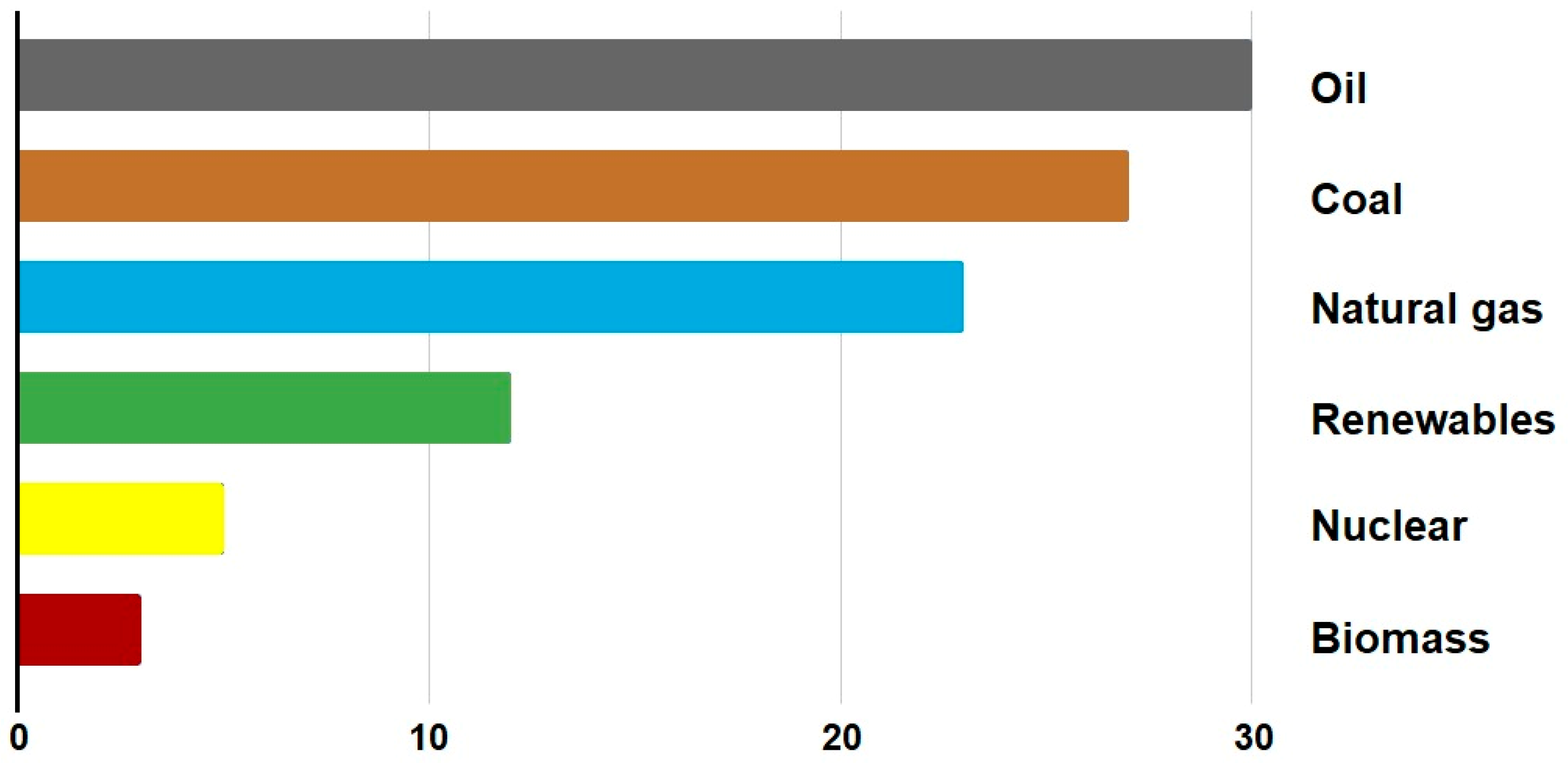
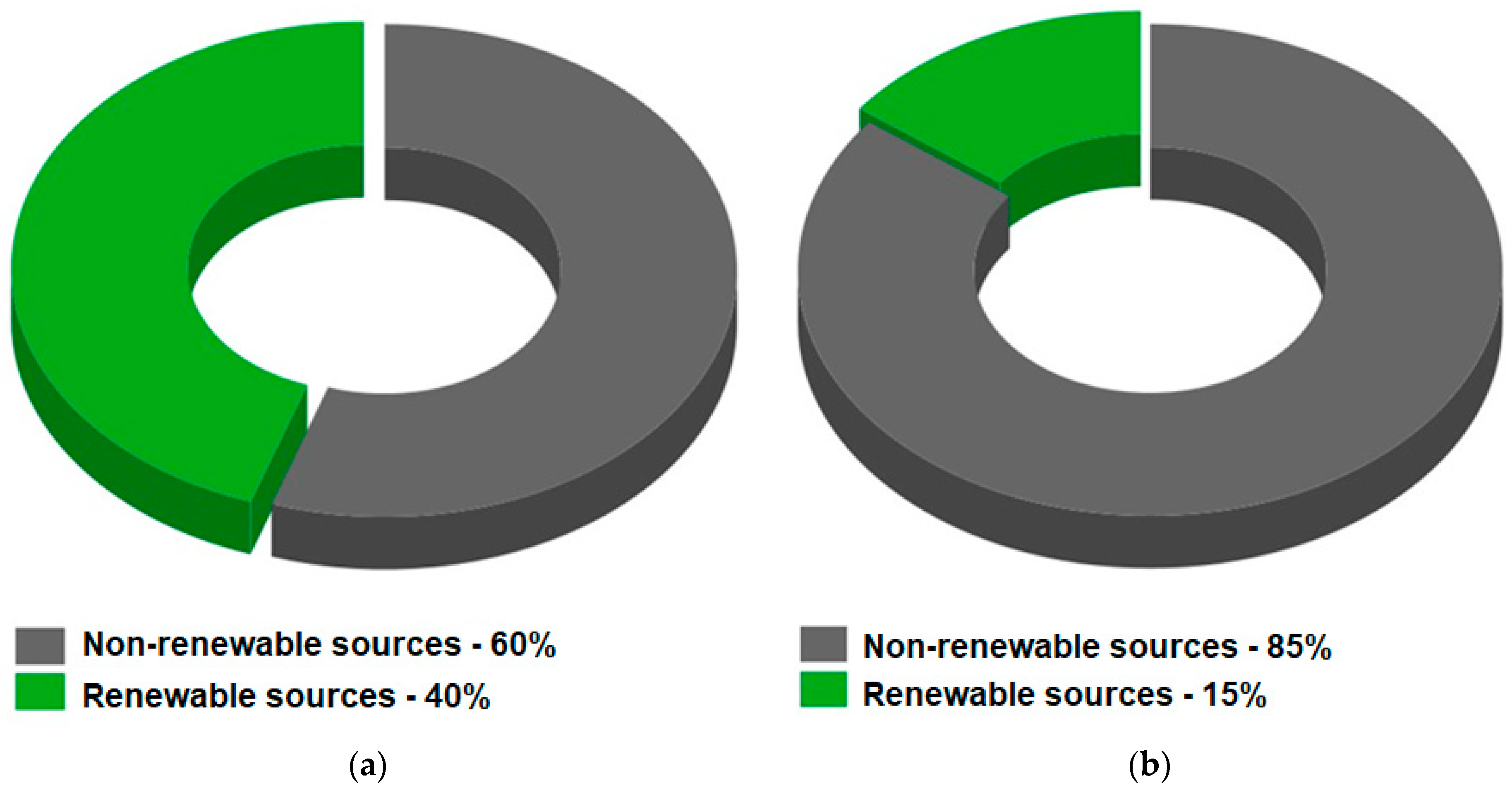
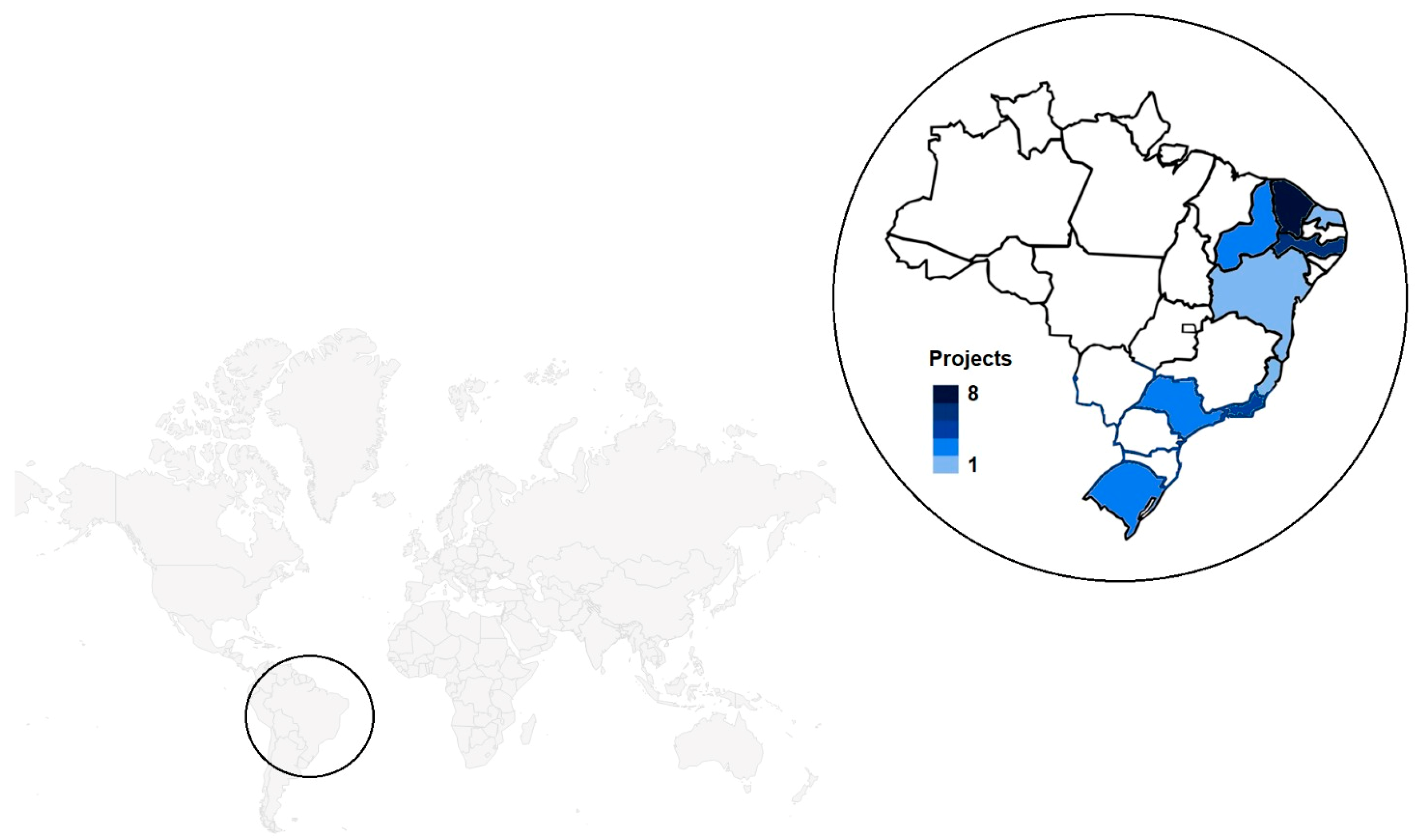
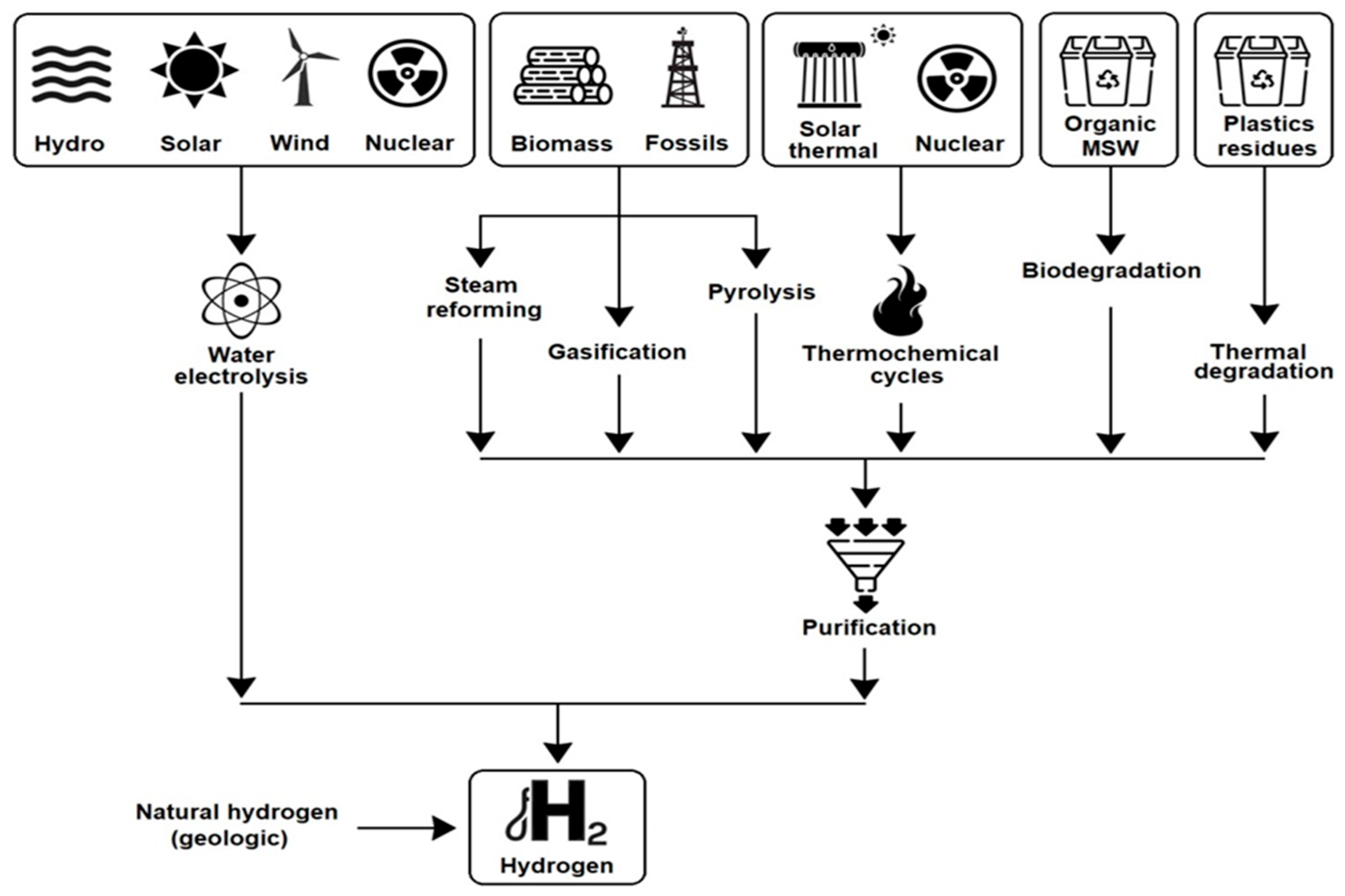
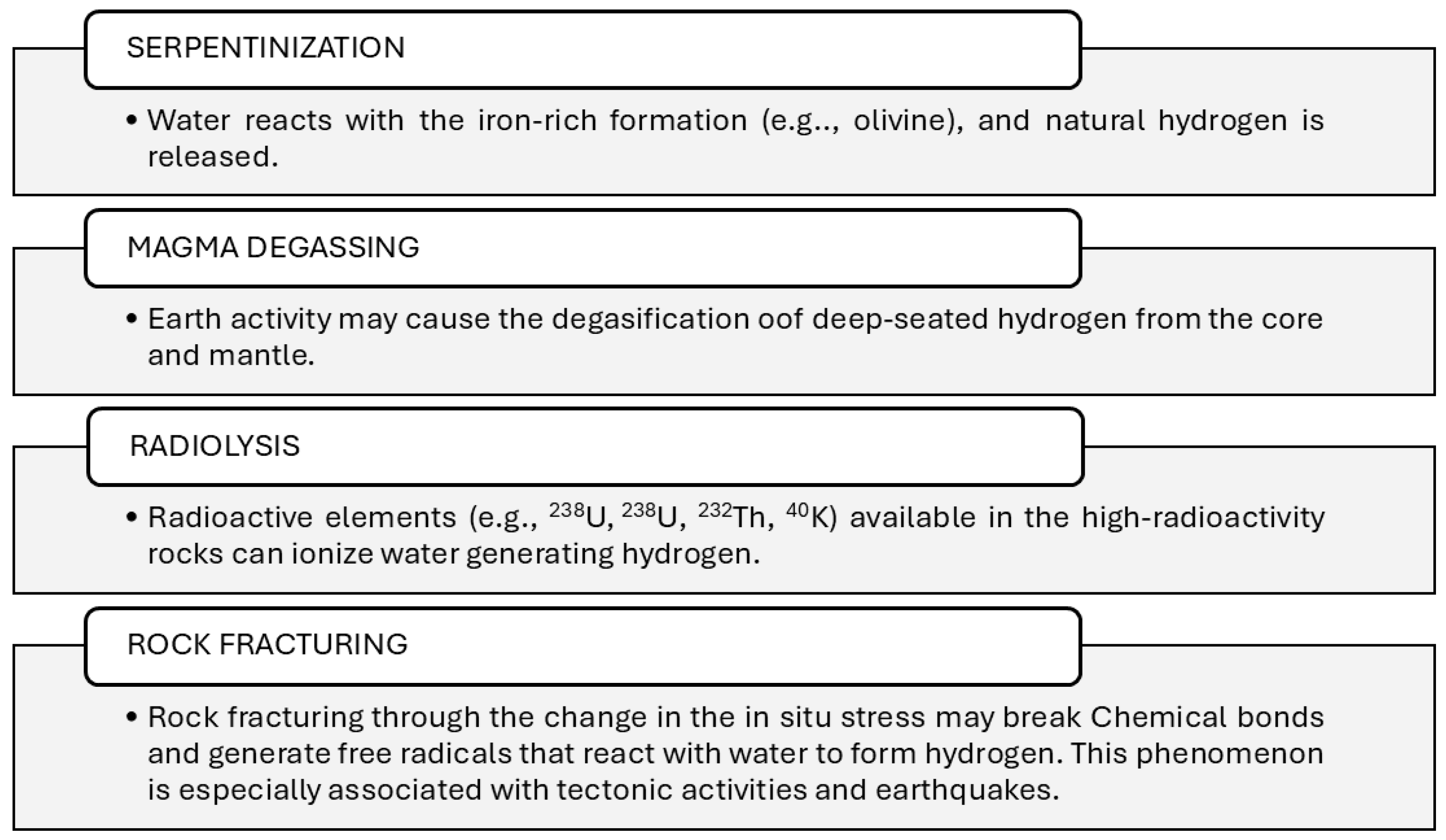

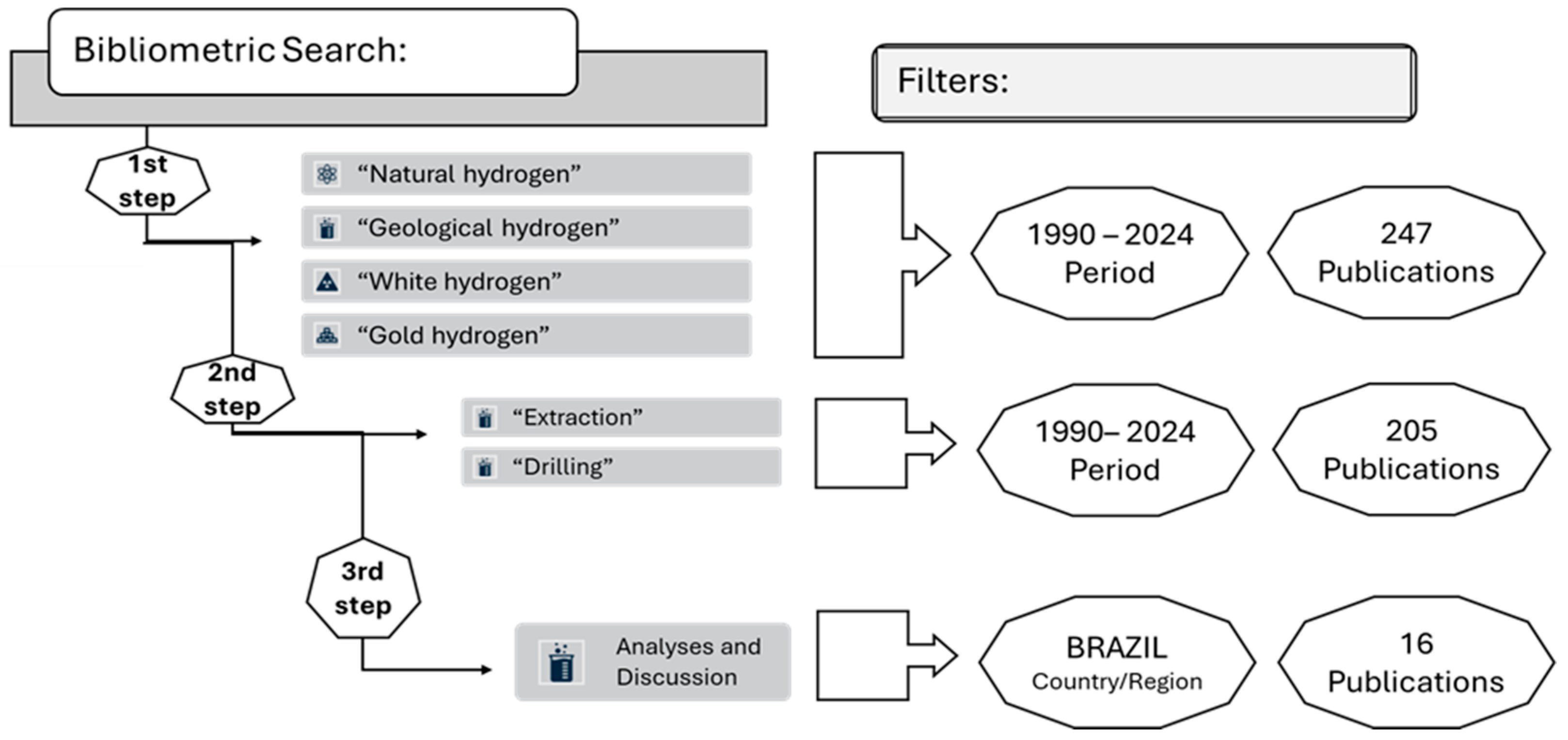



| Article Title | Journal | Year | Reference | N° Citation |
|---|---|---|---|---|
| Discovery of a large accumulation of natural hydrogen in Bourakebougou (Mali) | International Journal of Hydrogen Energy | 2018 | [64] | 95 |
| Natural hydrogen continuous emission from sedimentary basins: The example of a Brazilian H2-emitting structure | International Journal of Hydrogen Energy | 2019 | [68] | 73 |
| The association of natural hydrogen and nitrogen: The ammonium clue? | International Journal of Hydrogen Energy | 2024 | [79] | 61 |
| Possible pathways for oil and gas companies in a sustainable future: From the perspective of a hydrogen economy | Renewable and Sustainable Energy Reviews | 2022 | [80] | 53 |
| Characterization of the spontaneously recharging natural hydrogen reservoirs of Bourakebougou in Mali | Scientific Reports | 2023 | [81] | 35 |
| Long-term monitoring of natural hydrogen superficial emissions in a Brazilian cratonic environment. Sporadic large pulses versus daily periodic emissions | International Journal of Hydrogen Energy | 2021 | [65] | 29 |
| Hydrogen Emanations in Intracratonic Areas: New Guidelines for Early Exploration Basin Screening | Geosciences | 2021 | [82] | 25 |
| H2 dynamics in the soil of a H2-emitting zone (Sao Francisco Basin, Brazil): Microbial uptake quantification and reactive transport modeling | Applied Geochemistry | 2020 | [83] | 20 |
| Genesis of natural hydrogen: New insights from thermodynamic simulations | International Journal of Hydrogen Energy | 2021 | [84] | 15 |
| What Pulsating H2 Emissions Suggest about the H2 Resource in the Sao Francisco Basin of Brazil | Geosciences | 2020 | [[85] | 15 |
| Reduction in deuterium content in carbon targets for 12C + 12C reaction studies of astrophysical interest | The European Physical Journal A | 2018 | [86] | 15 |
| Water behavior in the neighborhood of hydrophilic and hydrophobic membranes: Lessons from molecular dynamics simulations | Physica A: Statistical Mechanics and its Applications | 2009 | [87] | 8 |
| Trapping processes of large volumes of natural hydrogen in the subsurface: The emblematic case of the Bourakebougou H2 field in Mali | International Journal of Hydrogen Energy | 2024 | [9] | 2 |
| Natural hydrogen and blend gas: a dynamic model of accumulation | International Journal of Hydrogen Energy | 2024 | [47] | 2 |
| Hydrogen storage in depleted offshore gas fields in Brazil: Potential and implications for energy security | International Journal of Hydrogen Energy | 2023 | [88] | 1 |
| Analysis and Multi-Objective Optimization of the Rate of Penetration and Mechanical Specific Energy: A Case Study Applied to a Carbonate Hard Rock Reservoir Based on a Drill Rate Test Using Play-Back Methodology | Applied Sciences | 2024 | [89] | 1 |
| Strengths | Weaknesses |
|---|---|
|
|
| Opportunities | Threats |
|
|
Disclaimer/Publisher’s Note: The statements, opinions and data contained in all publications are solely those of the individual author(s) and contributor(s) and not of MDPI and/or the editor(s). MDPI and/or the editor(s) disclaim responsibility for any injury to people or property resulting from any ideas, methods, instructions or products referred to in the content. |
© 2025 by the authors. Licensee MDPI, Basel, Switzerland. This article is an open access article distributed under the terms and conditions of the Creative Commons Attribution (CC BY) license (https://creativecommons.org/licenses/by/4.0/).
Share and Cite
Dornelas, V.F.; Nascimento, A.; Mantegazini, D.Z.; Lora, E.E.S.; Bortoni, E.d.C.; Amro, M. Occurrences and Perspectives of Natural Hydrogen Extraction: The Brazilian Context. Energies 2025, 18, 2859. https://doi.org/10.3390/en18112859
Dornelas VF, Nascimento A, Mantegazini DZ, Lora EES, Bortoni EdC, Amro M. Occurrences and Perspectives of Natural Hydrogen Extraction: The Brazilian Context. Energies. 2025; 18(11):2859. https://doi.org/10.3390/en18112859
Chicago/Turabian StyleDornelas, Vitória Felicio, Andreas Nascimento, Diunay Zuliani Mantegazini, Electo Eduardo Silva Lora, Edson da Costa Bortoni, and Mohd Amro. 2025. "Occurrences and Perspectives of Natural Hydrogen Extraction: The Brazilian Context" Energies 18, no. 11: 2859. https://doi.org/10.3390/en18112859
APA StyleDornelas, V. F., Nascimento, A., Mantegazini, D. Z., Lora, E. E. S., Bortoni, E. d. C., & Amro, M. (2025). Occurrences and Perspectives of Natural Hydrogen Extraction: The Brazilian Context. Energies, 18(11), 2859. https://doi.org/10.3390/en18112859









